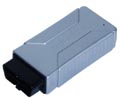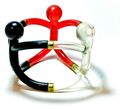adaptive headlights (AHL) System Functions
System functions
The adaptive headlights system adjusts the horizontal aim of the headlights (i.e. from side to side) in order to illuminate the inside of a bend when cornering.
The following functions of the adaptive headlights system are described below:
- System activation and automatic calibration
- Activation of stepper motor controller (SMC)
- Speed-dependent analysis of input variables
- Adjustment of headlight horizontal aim
- Deactivation of adaptive headlights function under extreme handling conditions
- Deactivation of adaptive headlights function in response to system faults
- Setting headlights to parked position
- Activation of automatic headlight-range adjustment by the AHL control unit
- Adaptive headlights in conjunction with automatic headlights
System activation and automatic calibration
Whenever the car is started, the headlights always perform an automatic calibration sequence even if the lights are not switched on. The AHL control unit activates the stepper motor controllers (SMC, control unit for headlight stepper motors).
The stepper motor controllers have the headlight positioner modules perform a calibration sequence as follows:
The headlights are moved slightly to the left, slightly upwards and then come to rest in the straight-ahead position.
There are 2 preconditions for activating the calibration sequence:
· If the dipped beam headlights are not switched on: the calibration sequence is carried out as soon as the engine is running.
· If the dipped beam headlights are switched on or the light switch is set to (A) for automatic: the calibration sequence is carried out if Terminal 15 is on.
Following the calibration sequence, the system is ready for operation.
If reverse gear is engaged, the adaptive headlights function is deactivated.
Activation of stepper motor controller (SMC)
The AHL control unit activates the stepper motor controller on the basis of the following input variables:
· Vehicle road speed
· Steering angle (at speeds up to 50 km/h, dependent on programming)
· Yaw rate (at speeds upwards of 50 km/h).
Speed-dependent analysis of input variables
Depending on the road speed of the vehicle, the adaptive headlights function is controlled on the basis of the signals from either the steering angle sensor or the yaw rate sensor (in the DSC sensor).
The programming determines at which speeds which sensor signals are given what priority.
Adjustment of headlight horizontal aim
Horizontal adjustment range of headlights
· Inwards (towards vehicle centre line): approx. 7-8 Deg
· Outwards: 15 Deg
The headlight on the outside of the bend must reach its limit of movement at the same time as the headlight on the inside so that illumination is constant and even.
Deactivation of adaptive headlights function under extreme handling conditions
If the vehicle drifts, skids or loses sideways grip, the adaptive headlights function is deactivated as follows:
- The headlights are returned to the straight-ahead position.
- The lights remain on. The headlights no longer adjust to the direction of the vehicle, however.
Deactivation of adaptive headlights function in response to system faults
If a system fault occurs, the indicator lamp flashes. The adaptive headlights function is deactivated as follows:
· If the stepper motors are still functional, the headlights are returned to the straight-ahead position.
· If one of the headlights has jammed in a position in which it could dazzle oncoming vehicles, the headlight concerned is switched off as soon as the vehicle is stationary. The front fog lamps are switched on in order to ensure a minimum level of illumination. The headlight is not switched off while the vehicle is in motion.
Setting headlights to parked position
The headlights are set to the parked position when Terminal R is switched off.
When Terminal R is switched off, the headlights move to the parked position as follows: The headlights move slightly to the right and downwards to the parked position.
Activation of automatic headlight-range adjustment by the AHL control unit
The automatic headlight-range adjustment moves the headlights up or down to compensate for differences in headlight range caused by changes in the before/aft inclination of the vehicle (e.g. due to differences in payload or extreme braking or acceleration).
If the (Adaptive headlights) option is fitted, the signals from the ride-height sensors and the brake light switch are read by the adaptive headlights control unit (AHL control unit).
The AHL control unit thus also controls the automatic headlight-range adjustment as follows:
· The ride height sensors on the front and rear suspension provide the AHL control unit with the input data for the headlight-range adjustment function. From the various input data received, the AHL control unit calculates the vehicle inclination (along the longitudinal axis, relative to the road surface).
Using the stepper motors for adjusting the vertical aim of the headlights, the headlight beam height is adjusted automatically and dynamically. The headlight beam height is adjusted so that the actual headlight range conforms to the legally required headlight range as follows:
· If vehicle rear is lower than front:
The actual headlight range will be longer than the legally stipulated range. The headlight beam height is lowered to reduce the headlight range to match the legal requirement.
· If the vehicle is horizontal:
The actual headlight range will be the same as the legally stipulated range.
· If vehicle front is lower than rear:
The actual headlight range will be shorter than the legally stipulated range. The headlight beam height is raised to increase the headlight range to match the legal requirement.
Adaptive headlights in conjunction with automatic headlights
The automatic headlights function switches on the dipped beam headlights in response to the ambient light conditions.
· The automatic headlights option must have been programmed (Car & Key Memory).
The light switch must be set to the automatic headlights position.
· The rain-light sensor detects the ambient light conditions and from the readings calculates whether or not the dipped beam headlights are required. If the light conditions are poor (e.g. at dawn/dusk or at night, in an underground car park or tunnel, in heavy rain), the rain-light sensor sends a (Switch on dipped beam headlights) request to the light module.
If there is sufficient ambient light, the rain-light sensor sends a (Switch off dipped beam headlights) request to the light module.
· The side lights and dipped beam headlights are automatically switched on under the following conditions: dawn/dusk, total darkness, entry into an underground car park, entry into a tunnel, rain (once the wiper frequency reaches a predetermined level) and snow (once the wiper frequency reaches a predetermined level, except on E46).
· If only the side lights are to be switched on, the light switch must be set to side lights (Position 1).
When the light switch is set to the (Automatic headlights) position (A), the AHL control unit is also activated as follows:
When the automatic headlights function switches on the dipped beam headlights, the adaptive headlights function is activated at the same time. The light module sends the message (Dipped beam headlights switched on) to the AHL control unit. The AHL control unit also takes account of the signals from the rain-light sensor.
The message (Dipped beam headlights switched on) is generated separately for each headlight unit.
If one of the headlights fails, the adaptive headlights function is deactivated.
The front fog lights are switched on in order to ensure a minimum level of illumination.
is one of the best Professional scan tools to for BMW; Autohex allows you to diagnose, code, program/flash ecus, replace with used ECUs, and add new keys for BMW. For more information: BMW Scan Tool
BMW Key Programming F10, All keys Lost


